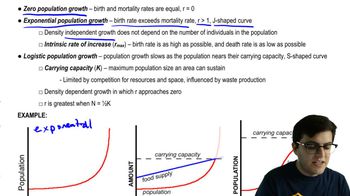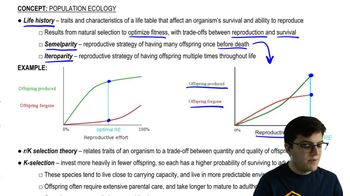Table of contents
- 1. Introduction to Biology2h 40m
- 2. Chemistry3h 40m
- 3. Water1h 26m
- 4. Biomolecules2h 23m
- 5. Cell Components2h 26m
- 6. The Membrane2h 31m
- 7. Energy and Metabolism2h 0m
- 8. Respiration2h 40m
- 9. Photosynthesis2h 49m
- 10. Cell Signaling59m
- 11. Cell Division2h 47m
- 12. Meiosis2h 0m
- 13. Mendelian Genetics4h 41m
- Introduction to Mendel's Experiments7m
- Genotype vs. Phenotype17m
- Punnett Squares13m
- Mendel's Experiments26m
- Mendel's Laws18m
- Monohybrid Crosses16m
- Test Crosses14m
- Dihybrid Crosses20m
- Punnett Square Probability26m
- Incomplete Dominance vs. Codominance20m
- Epistasis7m
- Non-Mendelian Genetics12m
- Pedigrees6m
- Autosomal Inheritance21m
- Sex-Linked Inheritance43m
- X-Inactivation9m
- 14. DNA Synthesis2h 27m
- 15. Gene Expression3h 20m
- 16. Regulation of Expression3h 31m
- Introduction to Regulation of Gene Expression13m
- Prokaryotic Gene Regulation via Operons27m
- The Lac Operon21m
- Glucose's Impact on Lac Operon25m
- The Trp Operon20m
- Review of the Lac Operon & Trp Operon11m
- Introduction to Eukaryotic Gene Regulation9m
- Eukaryotic Chromatin Modifications16m
- Eukaryotic Transcriptional Control22m
- Eukaryotic Post-Transcriptional Regulation28m
- Eukaryotic Post-Translational Regulation13m
- 17. Viruses37m
- 18. Biotechnology2h 58m
- 19. Genomics17m
- 20. Development1h 5m
- 21. Evolution3h 1m
- 22. Evolution of Populations3h 52m
- 23. Speciation1h 37m
- 24. History of Life on Earth2h 6m
- 25. Phylogeny2h 31m
- 26. Prokaryotes4h 59m
- 27. Protists1h 12m
- 28. Plants1h 22m
- 29. Fungi36m
- 30. Overview of Animals34m
- 31. Invertebrates1h 2m
- 32. Vertebrates50m
- 33. Plant Anatomy1h 3m
- 34. Vascular Plant Transport2m
- 35. Soil37m
- 36. Plant Reproduction47m
- 37. Plant Sensation and Response1h 9m
- 38. Animal Form and Function1h 19m
- 39. Digestive System10m
- 40. Circulatory System1h 57m
- 41. Immune System1h 12m
- 42. Osmoregulation and Excretion50m
- 43. Endocrine System4m
- 44. Animal Reproduction2m
- 45. Nervous System55m
- 46. Sensory Systems46m
- 47. Muscle Systems23m
- 48. Ecology3h 11m
- Introduction to Ecology20m
- Biogeography14m
- Earth's Climate Patterns50m
- Introduction to Terrestrial Biomes10m
- Terrestrial Biomes: Near Equator13m
- Terrestrial Biomes: Temperate Regions10m
- Terrestrial Biomes: Northern Regions15m
- Introduction to Aquatic Biomes27m
- Freshwater Aquatic Biomes14m
- Marine Aquatic Biomes13m
- 49. Animal Behavior28m
- 50. Population Ecology3h 41m
- Introduction to Population Ecology28m
- Population Sampling Methods23m
- Life History12m
- Population Demography17m
- Factors Limiting Population Growth14m
- Introduction to Population Growth Models22m
- Linear Population Growth6m
- Exponential Population Growth29m
- Logistic Population Growth32m
- r/K Selection10m
- The Human Population22m
- 51. Community Ecology2h 46m
- Introduction to Community Ecology2m
- Introduction to Community Interactions9m
- Community Interactions: Competition (-/-)38m
- Community Interactions: Exploitation (+/-)23m
- Community Interactions: Mutualism (+/+) & Commensalism (+/0)9m
- Community Structure35m
- Community Dynamics26m
- Geographic Impact on Communities21m
- 52. Ecosystems2h 36m
- 53. Conservation Biology24m
50. Population Ecology
Introduction to Population Ecology
Problem 2d
Textbook Question
Explain why a decrease in population growth rate is expected as a nonhuman population approaches carrying capacity.
 Verified step by step guidance
Verified step by step guidance1
Understand the concept of carrying capacity: Carrying capacity, denoted as 'K', is the maximum population size of a species that an environment can sustain indefinitely, given the food, habitat, water, and other necessities available in the environment.
Recognize the role of resources: As the population size increases and approaches the carrying capacity, the availability of resources (such as food and water) begins to decline due to higher consumption rates.
Consider the impact of resource limitation: With fewer resources available per individual, the growth rate of the population begins to slow down. This is because competition for limited resources increases, which can lead to higher mortality rates and lower birth rates.
Apply the logistic growth model: The logistic growth equation, which models population growth, shows this trend mathematically. It is represented as \( \frac{dN}{dt} = rN \left(1 - \frac{N}{K}\right) \), where \(N\) is the population size, \(r\) is the intrinsic rate of increase, and \(K\) is the carrying capacity. As \(N\) approaches \(K\), the term \(\left(1 - \frac{N}{K}\right)\) approaches zero, which in turn causes the growth rate \(\frac{dN}{dt}\) to approach zero.
Acknowledge density-dependent factors: Factors such as predation, disease, and territoriality become more significant as populations grow denser. These density-dependent factors further contribute to the slowing of population growth as it nears the carrying capacity.
Recommended similar problem, with video answer:
 Verified Solution
Verified SolutionThis video solution was recommended by our tutors as helpful for the problem above
Video duration:
31sPlay a video:
Was this helpful?
Key Concepts
Here are the essential concepts you must grasp in order to answer the question correctly.
Carrying Capacity
Carrying capacity refers to the maximum number of individuals of a particular species that an environment can sustainably support. It is determined by the availability of resources such as food, water, and habitat space. As a population approaches this limit, the growth rate typically slows due to increased competition for these limited resources.
Recommended video:
Guided course

Estimating Earth’s Human Carrying Capacity
Population Growth Rate
Population growth rate is the rate at which the number of individuals in a population increases over a specific period. It is influenced by factors such as birth rates, death rates, immigration, and emigration. As a population nears its carrying capacity, the growth rate declines due to resource limitations and increased mortality, leading to a more stable population size.
Recommended video:
Guided course

Population Growth Rate vs. Per Capita Population Growth Rate
Density-Dependent Factors
Density-dependent factors are environmental influences that affect a population's growth in relation to its density. These include competition for resources, predation, disease, and waste accumulation. As population density increases, these factors become more pronounced, contributing to a decrease in the growth rate as the population approaches carrying capacity.
Recommended video:
Guided course

Density-Dependent Factors

 1:17m
1:17mWatch next
Master Population Ecology with a bite sized video explanation from Jason Amores Sumpter
Start learningRelated Videos
Related Practice



































































